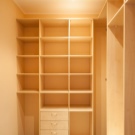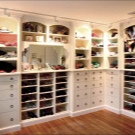Wardrobe shelves
Regiments for wardrobe carry out not only practical, but also esthetic function. Therefore, their choice should be taken with all responsibility.
Types
Shelves for wardrobe can be stationary (non-removable) and mobile (removable).
Fixed
The first version of the shelves involves a one-time installation. As a rule, they make wall and floor options for wardrobe. They are most often made from MDF or chipboard. This is a very democratic version of the designs. The shelves of these materials weigh relatively little and at the same time are quite durable. However, their composition may contain chemicals, so they cannot be called completely environmentally friendly.
Sometimes in more expensive systems, shelves are made from solid wood or from a dial-up array. Both of these materials are highly durable, so they are mainly placed on overall and heavy objects: suitcases, tool boxes, household appliances, and so on.These materials are environmentally friendly, but also high cost. Although typesetting array is somewhat cheaper than wood. At the same time, the quality is in no way inferior to him - after all, it consists of the same wood, only instead of one thick wooden plate there are several thin ones.
Fittings for mounting stationary shelves are different:
- Consignment, when the holder is attached to the wall itself, and the shelf is either attached on top, or just lying. So usually fix shelves of solid wood, chipboard and MDF.
- Mortise, mounted inside the product itself. Also applicable for wood or chipboard.
- Brackets - Shelves - this is one of the types of invoice fittings, but used exclusively for glass. In the bracket itself there are rubber pads to protect the shelf from deformation. They are able to withstand heavy loads.
- Retractable - used for greater ease of use of cabinets.
- Guides - attached to the wall or to the gable.
- Limiters have the shape of a square or semicircle.
Removable
For such shelves choose a material that does not lose its shape with repeated perturbations. It can be glass, metal or plastic shelves.Also, removable designs are sometimes made of solid wood.
- Glass shelves compared to chipboard shelves, much thinner, but not inferior in strength to them. Safety glass constructions are resistant to mechanical stress. Shelves for wardrobe can be made of ordinary clear glass, and you can experiment with color and choose shelves of frosted or silver glass. Possessing high light transmission properties, glass models with built-in LED lighting look very impressive in open wardrobe systems. If you chose this ecological material for your dressing room, it would be more expedient to arrange such shelves on top.
- Metal shelves for the dressing room most often have the shape of a grid. They are very light and thin. Mesh shelves are used mainly for things with low weight - bedding and underwear, summer clothes and so on. The advantage of such shelves in their mobility. They can be swapped and moved vertically and horizontally, as the details of the designer.
Such shelves are almost always made of steel and have a coating of impact-resistant enamel, which allows you to avoid accidental chips on them. And what is especially important for allergy sufferers - they are non-toxic and dust does not sit on them.
Accessories for sliding shelves:
- ball guides provide movement of the shelf by analogy with the bearing due to the balls. Such a mechanism can be fully or partially retractable. Provide smooth and quiet operation.
- roller guides - partial extension mechanism. Often to create the sides to the shelves complete with roller guides attached retractable gallery, which is a side guards.
- telescopes with the closer provide the smooth and silent movement of a design. The most popular mechanisms for hidden installation - they are mounted under the shelf or drawer and they are not visible when opening. Such a mechanism is particularly durable and is therefore often used in expensive solid wood furniture.
Accessories for rotating shelves:
- mount for the base - upper and lower.
- axis of rotation (base) - a metal pipe or pole, on which the shelves are held. The height of the axis can be changed with reference to the cabinet.
- flanges for fastening structures.
Shoe
Each wardrobe room must have a shoe closet or at least a shelf for shoes.The simplest solution for storing shoes is a built-in wardrobe in the entire height of the room. Or it may be small cabinets, placed under the clothes hangers. They can be divided thematically - winter shoes under outerwear, and summer - under the wardrobe with light things. Sneakers and ballet flats will be stored in the compartment for sportswear, and elegant stiletto heels will be under the dresses on the way out.
There are options for shelving with stationary shelves at an angle of 45 degrees. The most preferred material for such shelves is metal. It does not absorb moisture, which means that the shelf will not crack when we put wet shoes on it. On such shelves, shoes are better viewed and not only shoes and boots can be put on them, but also high boots.
Many manufacturers offer cabinets for shoes with sliding shelves - they are mainly made of wooden texture - an array or veneer.
Very comfortable cabinets with rotating shelves. They are also called carousels, because they have a turning angle of 360 degrees. Material for their manufacture will suit any - plastic, wood, veneer, metal.
The requirements for shoe shelves are very simple.The width of the shelf should be slightly larger than the largest shoe pair. It is desirable to divide the shelves by sectors into three floors so that dust does not sit on them. For these purposes, you can equip the shoe rack doors - for a better view they can be made of frosted glass.
Practice shows that the optimal size of the section should be designed for three pairs of shoes.
Design options
Shelves in the dressing room are selected depending on the design of the dressing room and its type. In the wardrobe in the style of minimalism or high tech will be appropriate glass and metal mesh air structures with hidden fixings.
If you are decorating a dressing room in the children's room, you can choose shelves made of colored plastic of bright colors, or paint them with the child. If the shelves have the form of a closed construction with sides, you can stick on them images of various wardrobe items, so that the child can more easily navigate in space.
For a classic dressing room in the bedroom, a great option for shelves with wooden texture of their veneer or solid array.
If the dressing room is open, you can choose the original design of the shelves with unusual shapes or non-uniform colors.However, in order not to “overload” the interior with an abundance of avant-garde, the calm moderate tone of the back wall is used for unusual shelves. And on such structures should be placed ordinary items.
If you already have a dressing room and you just want to update the picture before your eyes, you can change the background of the wall on which the shelves are located - for example, apply wallpaper or a bright unusual sticker with a large pattern. The theme of such stickers may be the most unexpected - an antique-style vase, a cat or a dog, or a musical instrument, if the owner of the room is interested in music. Also between the shelves can be installed, for example, a hanger for ties and belts, or racks for umbrellas.
The shelves look like an extraordinary snake (or train), when one shelf is a continuation of the next and all of them are located one behind the other at different heights and distances. This is very refreshing interior and make it more modern.
The simplest shelf with the most ordinary basis can be decorated with improvised means and make it trendy and exclusive. The design and texture of any shelf can be changed using conventional fabric, veneer or self-adhesive film.If you still have pieces of old wallpaper, you can paste over the shelves with them, and then they will be one with the wall. The whole structure will seem hovering in zero gravity.







































































